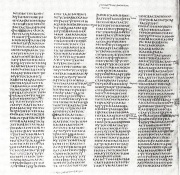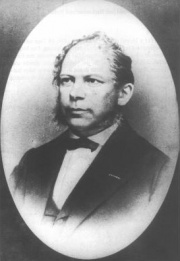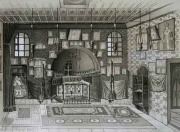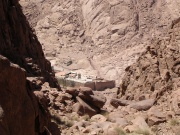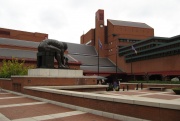Codex Sinaiticus
From Textus Receptus
Codex Sinaiticus (Shelfmarks and references: London, British Library, Additional 43725; Gregory-Aland nº א (Aleph) or 01, (Soden δ 2) is known as one of the most important hand-written ancient copies of the Greek Bible. It was written in the 4th century, in uncial letters. It came to the attention of scholars in the 19th century at the Greek Monastery of Mount Sinai, with further material discovered in the 20th century, and most of it is today in the British Library.
Originally it contained the whole of both Testaments. The Greek Old Testament (or Septuagint) survived almost complete, along with a complete New Testament, plus the Epistle of Barnabas, and portions of The Shepherd of Hermas. [1]
Contents |
Description
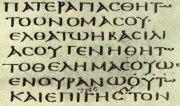
The work was written in scriptio continua with neither breathings nor polytonic accents. Occasional points and few ligatures are used, though nomina sacra with overlines are employed throughout. Some words usually abbreviated in other manuscripts (such as πατηρ and δαυειδ), in this codex written in full and abbreviated. Almost regularly, a plain iota is substituted for the epsilon-iota diphthong (error of iotacism), e.g. δαυειδ instead δαυιδ. [2]
Each line has some twelve to fourteen Greek uncial letters, arranged in four columns (48 lines in column) with carefully-chosen line breaks and slightly ragged right edges. [3] In result the eight columns thus presented to the reader when the volume is opened have much of the appearance of the succession of columns in a papyrus roll. [4] The poetical books of the Old Testament written in στίχοι, only in two columns per page. There are no breathings or accents.<ref>Scrivener F. H. A., (1864). A Full Collation of the Codex Sinaiticus with the Received Text of the New Testament, Cambridge: Deighton, Bell, and Co., p. XIII.</ref> The codex has almost 4 000 000 uncial letters.<ref group="n">It was estimated by Tischendorf and used by Scrivener in his Introduction to the Sinaitic Codex (1867) as an argument against authorship of Simonides (‘‘Christianity’’, p. 1889.)</ref>
Each rectangular page has the proportions 1.1 to 1, while the block of text has the reciprocal proportions, 0.91 (the same proportions, rotated 90°). If the gutters between the columns were removed, the text block would mirror the page's proportions. Typographer Robert Bringhurst referred to the codex as a "subtle piece of craftsmanship".<ref>Bringhurst, Robert (2004). The Elements of Typographic Style (version 3.0), pp. 174–75. Vancouver: Hartley & Marks. ISBN 0-88179-205-5.</ref>
The folios are made of vellum parchment made from donkey or antelope skin. Most of the quires or signatures contain four leaves save two containing five. It is estimated that about 360 animals were slaughtered for making the folios of this codex, assuming all animals yielded a good enough skin. As for the cost of the material, time of scribes and binding, it equals the life time wages of one individual at the time.<ref name = Bruce/>
The portion of the codex held by the British Library consists of 346½ folios, 694 pages (38.1 cm x 34.5 cm), constituting over half of the original work. Of these folios, 199 belong to the Old Testament including the apocrypha and 147½ belong to the New Testament, along with two other books, the Epistle of Barnabas and part of The Shepherd of Hermas. The apocryphal books present in the surviving part of the Septuagint are 2 Esdras, Tobit, Judith, 1 & 4 Maccabees, Wisdom and Sirach.<ref name = Bruce/><ref>The Codex Sinaiticus Website</ref> The books of the New Testament are arranged in this order: the four Gospels, the epistles of Paul (Hebrews follows 2 Thess), the Acts of the Apostles,<ref group="n">Also in Minuscule 69 and several other minuscule manuscripts Pauline epistles precede Acts. </ref> the General Epistles, and the Book of Revelation. The fact that some parts of the codex are preserved in good condition, while others are in very poor condition, implies they were separated and stored in several places.<ref name = Skeat> Skeat, T. C. "The Last Chapter in the History of the Codex Sinaiticus", Novum Testamentum XLII, 4, pp. 313-315. </ref>
The text of the codex
Lacunae
The text of the Old Testament lacks the following passages:<ref>Würthwein Ernst (1987). Der Text des Alten Testaments, Stuttgart: Deutsche Bibelgesellschaft, p. 85. </ref>
- Genesis 23:19 - Genesis 24:46 — fragments
- Numbers 5:26–Numbers 7:20 — fragments
- 1 Chronicles 9:27–1 Chronicles 19:17
- Ezra-Nehemiah (from Esdr 9:9).

The text of New Testament lacks several passages:<ref>Bruce M. Metzger (2001). "A Textual Commentary on the Greek New Testament", Deutsche Bibelgesellschaft, Stuttgart: United Bible Societies.</ref>
- Omitted verses
- Gospel of Matthew Matthew 12:47, 16:2b-3, Matthew 17:21, Matthew 18:11
- Gospel of Mark Mark 9:44, Mark 9:46, Mark 15:28, 16:9-20 (Long ending of the Gospel Mark)
- Gospel of Luke Luke 17:36, Luke 22:43-44 (included by the original scribe, marked by the first corrector as doubtful, but a third corrector removed the mark)
- Gospel of John John 5:4, Pericope adulterae (7:53-8:11) (see Image "John 7:53-8:11"), John 21:25
- Epistle to the Romans 16:24
- Omitted phrases
- Matthew 6:13 "For thine is the kingdom, and the power, and the glory, for ever. Amen." omitted.
- Matthew 13:35 "son of Barachiah" omitted.
- 1:1 "the Son of God" omitted.
- Luke 23:34, "Then said Jesus, Father, forgive them; for they know not what they do" - included by the original scribe, marked by the first corrector as doubtful, but a third corrector removed the mark.
These omissions are typical for the Alexandrian text-type.
Interpolation in Matt 27:49
In Gospel of Matthew 27:49 codex contains added text: ἄλλος δὲ λαβὼν λόγχην ἒνυξεν αὐτοῦ τὴν πλευράν, καὶ ἐξῆλθεν ὖδορ καὶ αἳμα (the other took a spear and pierced His side, and immediately came out water and blood). This reading was derived from John 19:34 and occurs in other manuscripts of the Alexandrian text-type.<ref>Bruce M. Metzger (2001). "A Textual Commentary on the Greek New Testament", Deutsche Bibelgesellschaft, Stuttgart: United Bible Societies, p. 59.</ref>
Unique textual variants
In Matthew 8:12 it has ἐξελεύσονται (will go out) instead of ἐκβληθήσονται (will be thrown). This variant is supported only by one Greek manuscript Uncial 0250, and by Codex Bobiensis, syrc, s, p, pal, arm, Diatessaron.<ref>UBS4, p. 26. </ref>
In Matthew 13:54 εις την πατριδα αυτου changed into εις την αντιπατριδα αυτου, and in Acts 8:5 εις την πολιν της Σαμαρειας replaced into εις την πολιν της Καισαριας. These two variants do not exist in any other manuscript, and it seems they were made by a scribe. According to T. C. Skeat they suggest Caesarea as a place in which the manuscript was made.<ref name=skeat-1999></ref>
In Matthew 16:12 it has textual variant της ζυμης των αρτων των Φαρισαιων και Σαδδουκαιων (leaven of bread of the Pharisees and Sadducees) supported only by Codex Corbeiensis I and Curetonian Gospels.
In John 1:28 second corrector made unique textual variant Βηθαραβα. This textual variant has only codex 892, syrh and several other manuscripts.<ref>http://www.bibletranslation.ws/trans/john.pdf</ref>
In John 1:34 it reads ὁ ἐκλεκτός (choosen one) together with the manuscripts <math>\mathfrak{P}</math>5, <math>\mathfrak{P}</math>106, b, e, ff2, syrc, and syrs instead of ordinary word υἱος (son).
In Luke 1:26 "Nazareth" is called "a city of Judea", in John 2:3, where is ordinary reading "And when they wanted wine", or "And when wine failed", Codex Sinaiticus has "And they had no wine, because the wine of the marriage feast was finished" (supported by a and j); in Acts 11:20 εὐαγγελιστας (Evangelists) instead of ἑλληνιστάς (Hellenists); in Acts 14:9 "not" inserted before "heard"; in Hebrews 2:4 "harvests" instead of "distributions"; in 1 Peter 5:13 word "Babylon" replaced into "Church".<ref>F. H. A. Scrivener, Six Lectures on the Text of the New Testament and the Ancient Manuscripts which contain it (Deighton, Bell, and Co: Cambridge; London, 1875), p. 47. </ref>
Text-type and relationship to other manuscripts
For most of the New Testament, Codex Sinaiticus is in general agreement with Codex Vaticanus and Codex Ephraemi Rescriptus, attesting the Alexandrian text-type. A notable example of an agreement between the Sinaiticus and Vaticanus texts is that they both omit the word εικη ('without cause', 'without reason', 'in vain') from Matthew 5:22 "But I say unto you, That whosoever is angry with his brother without a cause shall be in danger of the judgment".<ref>The same variant present manuscripts: P67, 2174, in manuscripts of Vulgate, and in manuscripts of Ethiopic version. </ref>
[[File:Codex sinaticus.jpg|thumb|A portion of the Codex Sinaiticus, containing Esther .]] In John 1:1-8:38 Codex Sinaiticus differs from Vaticanus and all other Alexandrian manuscripts. It is in closer agreement with Codex Bezae in support of the Western text-type. For example, in John 1:3 Sinaiticus and Codex Bezae are the only Greek manuscripts with textual variant ἐν αὐτῷ ζωὴ ἐστίν (in him is life) instead of ἐν αὐτῷ ζωὴ ᾓν (in him was life). This variant is supported by Vetus Latina and some Sahidic manuscripts. This portion has a large number of corrections.<ref>Fee, G. D. (1968-9). Codex Sinaiticus in the Gospel of John, NTS 15, pp. 22-44.</ref> There is a number of differences between Sinaiticus and Vaticanus; Hoskier enumerated 3036 differences:
- Matt–656
- Mark–567
- Luke–791
- John–1022
- Total—3036.<ref>Hoskier, H. C. (1914). Codex B and Its Allies, a Study and an Indictment, London, p.1. </ref>
A large number of these differences are due to iotacisms and variants in transcribing Hebrew names. These two manuscripts were not written in the same scriptorium. According to Hort Sinaiticus and Vaticanus were derived from a common original much older, "the date of which cannot be later than the early part of the second century, and may well be yet earlier".<ref> Westcott, B. F. and Hort, F. J. A. (1860). Introduction to the Study of the Gospels, p.40. </ref>
Example of differences between Sinaiticus and Vaticanus in Matt 1:18-19:
| Codex Sinaiticus | Codex Vaticanus |
|---|---|
| Του δε ΙΥ ΧΥ η γενεσις ουτως ην μνηστευθισης της μητρος αυτου Μαριας τω Ιωσηφ πριν ην συνελθιν αυτους ευρεθη εν γαστρι εχουσα εκ ΠΝΣ αγιου Ιωσηφ δε ο ανηρ αυτης δικαιος ων και μη θελων αυτην παραδιγματισαι εβουληθη λαθρα απολυσαι αυτην | Του δε ΧΥ ΙΥ η γενεσις ουτως ην μνηστευθεισης της μητρος αυτου Μαριας τω Ιωσηφ πριν ην συνελθειν αυτους ευρεθη εν γαστρι εχουσα εκ ΠΝΣ αγιου Ιωσηφ δε ο ανηρ αυτης δικαιος ων και μη θελων αυτην δειγματισαι εβουληθη λαθρα απολυσαι αυτην |
B. H. Streeter remarked a great agreement between the codex and Vulgate of Jerome. According to him Origen brought to Caesarea the Alexandrian text-type which was used in this codex, and used by Jerome.<ref name = Streeter>Streeter, B. H. (1924). The Four Gospels, a Study of Origins treating of the Manuscript Tradition, Sources, Authorship, & Dates, pp. 590-597.</ref>
Between the 4th and 12th centuries, seven or more correctors worked on this codex, making it one of the most corrected manuscripts in existence.<ref> Milne, H. J. M. and Skeat, T.C. (1938). Scribes and Correctors of Codex Sinaiticus. London: Trustees of the British Museum. </ref> Tischendorf during his investigation in Petersburg enumerated 14 800 corrections only in portion which was held in Petersburg (2/3 of the codex).<ref name = Metzger77>Metzger, Bruce M., (1991). Manuscripts of the Greek Bible: An Introduction to Palaeography, Oxford: Oxford University Press, p. 77.</ref> It means all the codex can have about 20 000 corrections. In addition to these corrections some letters were marked by dots as doubtful (e.g. ṪḢ). Corrections represent the Byzantine text-type, just like in codices: Bodmer II, Regius (L), Ephraemi (C), and Sangallensis (Δ). They were discovered by Button.<ref>Button, E. A. (1911). An Atlas of Textual Criticism, Cambridge, p. 13.</ref>
History of the codex
Early history of codex
Little is known of the manuscript's early history. According to Hort, it was written in the West, probably Rome. Kenyon, Gardthausen, Ropes and Jellicoe thought it was written in Egypt. Harris, Streeter,<ref name = Streeter/> Skeat, and Milne tended to think that it was produced in Caesarea. It was written in the fourth century. It could not have been written before A.D. 325 because it contains the Eusebian Canons, and it is a terminus post quem. It could not be written after A.D. 360 because of certain references to Church fathers in the margin. It means A.D. 360 is a terminus ad quem.<ref name = Bruce/>
According to Tischendorf, Codex Sinaiticus was one of the fifty copies of the Bible commissioned from Eusebius by Roman Emperor Constantine after his conversion to Christianity (De vita Constantini, IV, 37).<ref>Price, I. M. (1923). The Ancestry of Our English Bible an Account of Manuscripts, Texts and Versions of the Bible, Sunday School Times Co, p. 146 f. </ref> T. C. Skeat believed that it was already in production when Constantine placed his order, but had to be suspended in order to accommodate different page dimensions.<ref name=skeat-1999/>
Tischendorf also believed that four separate scribes copied the work (whom he named A, B, C and D) and that five correctors (whom he designated a, b, c, d and e) amended portions. He posited that one of the correctors was contemporaneous with the original scribes, and that the others dated to the sixth and seventh centuries. Modern analysis identifies at least three scribes. Scribe B was a poor speller, and scribe A was not very much better; the best scribe was D.<ref name = Bruce/> Scribe A wrote most of the historical and poetical books of the Old Testament, almost the whole of the New Testament, and Epistle of Barnabas. Scribe B was responsible for the Prophets and the Shepherd of Hermas. Scribe D wrote the whole of Tobit and Judith, the first half of 4 Maccabees, and first 2/3 of the Psalms, and first five verses of Revelation. A made unusually serious mistake.<ref name = Metzger77/> It is now agreed, after Milne and Skeat's reinvestigation, that Tischendorf was wrong—scribe C never existed.<ref>Milne, H. J. M. and Skeat, T. C., (1938). Scribes and Correctors of the Codex Sinaiticus, London: British Museum, pp. 22-50.</ref> According to Tischendorf, scribe C wrote poetic books of the Old Testament. These are written in a different format from the rest of the manuscript — they are in two columns (the rest of books is in four colums) and written stichometrically. Tischendorf probably interpreted the different formatting as indicating the existence of another scribe.<ref name = Jongkind>Jongkind, Dirk (2007), pp. 22-50. Scribal Habits of Codex Sinaiticus, Gorgias Press LLC, pp. 12-13. </ref> The three remaining scribes are still identified by the letters that Tischendorf gave them: A, B, and D.<ref name = Jongkind/> Correctors were more, at least seven (a, b, c, ca, cb, cc, e).<ref name = Aland/>
A paleographical study at the British Museum in 1938 found that the text had undergone several corrections. The first corrections were done by several scribes before the manuscript left the scriptorium. In the sixth or seventh century, many alterations were made, which, according to a colophon at the end of the book of Esdras and Esther states, that the source of these alterations was "a very ancient manuscript that had been corrected by the hand of the holy martyr Pamphylus" (martyred AD 309). If this is so, material which begin with 1 Samuel to the end of Esther is Origen's copy of the Hexapla. From this colophon, the correction is concluded to have been made in Caesarea Maritima in the 6th or 7th centuries.<ref>Metzger, Bruce M., (1992). The Text of the New Testament: Its Transmission, Corruption and Restoration, (3rd Ed.), Oxford: Oxford University Press, p. 46.</ref> The pervasive iotacism, especially of the diphthong, remains uncorrected.
Discovery
The Codex was probably seen in 1761 by the Italian traveller, Vitaliano Donati, when he visited Monastery of Saint Catherine at Sinai. His diary was published in 1879, in which was written:
“In questo monastero ritrovai una quantità grandissima di codici membranacei… ve ne sono alcuni che mi sembravano anteriori al settimo secolo, ed in ispecie una Bibbia in membrane bellissime, assai grandi, sottili, e quadre, scritta in carattere rotondo e belissimo; conservano poi in chiesa un Evangelistario greco in caractere d’oro rotondo, che dovrebbe pur essere assai antico”.<ref> Lumbroso, G. (1879). Atti della R. Accademia dei Lincei, p. 501. </ref>“Bibbia in membrane bellissime... scritta in carattere rotondo e belissimo” it is probably the Codex Sinaiticus. In 1844, during his first visit to Monastery of Saint Catherine, Tischendorf claimed that he saw some leaves of parchment in a waste-basket. He said they were "rubbish which was to be destroyed by burning it in the ovens of the monastery",<ref>Skeat, T. C. (2000). "The Last Chapter in the History of the Codex Sinaiticus." Novum Testamentum. Vol. 42, Fasc. 3, Jul., 2000. p. 313.</ref> although this is firmly denied by the Monastery. After examination he realized that they were part of the Septuagint, written in an early Greek uncial script. He retrieved from the basket 129 leaves in Greek which he identified as coming from a manuscript of the Septuagint. He asked if he might keep them, but at this point the attitude of the monks changed, they realized how valuable these old leaves were, and Tischendorf was permitted to take only one-third of the whole, i.e. 43 leaves. These leaves contained portions of 1 Chronicles, Jeremiah, Nehemiah, and Esther. After his return they were deposited in the University Library at Leipzig, where they still remain. In 1846 Tischendorf published their contents, naming them the 'Codex Frederico-Augustanus' (in honor of Frederick Augustus). In the monastery left other portions of the same codex, containing all of Isaiah and 1 and 4 Maccabees.<ref> Tischendorf, K.v. (1866). When Were Our Gospels Written? An Argument by Constantine Tischendorf. With a Narrative of the Discovery of the Sinaitic Manuscript, New York: American Tract Society. </ref>
In 1845 Archimandrite Porfirij Uspenskij (1804-1885), at that time head of the Russian Ecclesiastical Mission in Jerusalem and subsequently Bishop of Chigirin, visited the monastery and the codex was shown to him, together with leaves which Tischendorf had not seen.<ref group="n"> Uspienski described: «Первая рукопись, содержащая Ветхий Завет неполный и весь Новый Завет с посланием ап. Варнавы и книгой Ермы, писана на тончайшем белом пергамене. (…) Буквы в ней совершенно похожи на церковно-славянские. Постановка их прямая и сплошная. Над словами нет придыханий и ударений, а речения не отделяются никакими знаками правописания кроме точек. Весь священный текст писан в четыре и два столбца стихомерным образом и так слитно, как будто одно длинное речение тянется от точки до точки.» (Порфирий (Успенский), Первое путешествие в Синайский монастырь в 1845 году, Petersburg 1856, с. 226.)</ref>
In 1853 Tischendorf revisited the monastery at Sinai, to get the remaining 86 folios, but without success. The Codex Sinaiticus was shown to Constantin von Tischendorf on his third visit to the Monastery of Saint Catherine, at the foot of Mount Sinai in Egypt, in 1859. (However, this story may have been a fabrication, or the manuscripts in question may have been unrelated to Codex Sinaiticus: Rev. J. Silvester Davies in 1863 quoted "a monk of Sinai who... stated that according to the librarian of the monastery the whole of Codex Sinaiticus had been in the library for many years and was marked in the ancient catalogues... Is it likely... that a manuscript known in the library catalogue would have been jettisoned in the rubbish basket." Indeed, it has been noted that the leaves were in "suspiciously good condition" for something found in the trash.<ref group="n"> Davies words are from a letter published in The Guardian on 27 May 1863, as quoted by Elliott, J.K. (1982) in Codex Sinaiticus and the Simonides Affair, Thessaloniki: Patriarchal Institute for Patristic Studies, p. 16; Elliott in turn is quoted by Michael D. Peterson in his essay "Tischendorf and the Codex Sinaiticus: the Saga Continues", in The Church and the Library, ed. Papademetriou and Sopko Boston: Somerset Hall Press (2005), p. 77. See also notes 2 and 3, p. 90, in Papademetriou.</ref>) Tischendorf had been sent to search for manuscripts by Russia's Tsar Alexander II, who was convinced there were still manuscripts to be found at the Sinai monastery. The text of this part of the codex was published by Tischendorf in 1862:
- Konstantin von Tischendorf: Bibliorum codex Sinaiticus Petropolitanus. Giesecke & Devrient, Leipzig 1862.
It was reprinted in four volumes in 1869:
- Konstantin von Tischendorf, G. Olms (Hrsg.): Bibliorum codex Sinaiticus Petropolitanus. 1. Prolegomena. G. Olms, Hildesheim 1969 (Repr.).
- Konstantin von Tischendorf, G. Olms (Hrsg.): Bibliorum codex Sinaiticus Petropolitanus. 2. Veteris Testamenti pars prior. G. Olms, Hildesheim 1969 (Repr.).
- Konstantin von Tischendorf, G. Olms (Hrsg.): Bibliorum codex Sinaiticus Petropolitanus. 3. Veteris Testamenti pars posterior. G. Olms, Hildesheim 1969 (Repr.).
- Konstantin von Tischendorf, G. Olms (Hrsg.): Bibliorum codex Sinaiticus Petropolitanus. 4. Novum Testamentum cum Barnaba et Pastore. G. Olms, Hildesheim 1969 (Repr.).
The complete publication of the codex was made by Kirsopp Lake in 1911 (New Testament),<ref>Kirsopp Lake, (1911). Codex Sinaiticus Petropolitanus: The New Testament, the Epistle of Barnabas and the Shepherd of Hermas, Oxford: Clarendon Press. </ref> and in 1922 (Old Testament). It was the full-sized black and white facsimile of the manuscript, made on the basis two earlier facimiles editing. Lake did not have access to the manuscript.

The story of how von Tischendorf found the manuscript, which contained most of the Old Testament and all of the New Testament, has all the interest of a romance. Von Tischendorf reached the monastery on 31 January; but his inquiries appeared to be fruitless. On 4 February, he had resolved to return home without having gained his object:
On the afternoon of this day I was taking a walk with the steward of the convent in the neighbourhood, and as we returned, towards sunset, he begged me to take some refreshment with him in his cell. Scarcely had he entered the room, when, resuming our former subject of conversation, he said: "And I, too, have read a Septuagint"—i.e. a copy of the Greek translation made by the Seventy. And so saying, he took down from the corner of the room a bulky kind of volume, wrapped up in a red cloth, and laid it before me. I unrolled the cover, and discovered, to my great surprise, not only those very fragments which, fifteen years before, I had taken out of the basket, but also other parts of the Old Testament, the New Testament complete, and, in addition, the Epistle of Barnabas and a part of the Shepherd of Hermas.<ref> See Constantin von Tischendorf, The Discovery of the Sinaitic Manuscript, Extract from Constantin von Tischendorf, (1866) When Were Our Gospels Written? An Argument by Constantine Tischendorf. With a Narrative of the Discovery of the Sinaitic Manuscript New York: American Tract Society.</ref>
After some negotiations, he obtained possession of this precious fragment. James Bentley gives an account of how this came about, prefacing it with the comment, "Tischendorf therefore now embarked on the remarkable piece of duplicity which was to occupy him for the next decade, which involved the careful suppression of facts and the systematic denigration of the monks of Mount Sinai."<ref> Bentley, James (1986). Secrets of Mount Sinai. Garden City, NY: Doubleday, p. 95.</ref> He conveyed it to Tsar Alexander II, who appreciated its importance and had it published as nearly as possible in facsimile, so as to exhibit correctly the ancient handwriting. The Tsar sent the monastery 9 000 rubles by way of compensation. Regarding Tischendorf's role in the transfer to Saint Petersburg, there are several views. Although when parts of Genesis and Book of Numbers were later found in the bindings of other books, they were amicably sent to Tischendorf, the codex is currently regarded by the monastery as having been stolen. This view is hotly contested by several scholars in Europe. Kirsopp Lake wrote:
Those who who have had much to do with Oriental monks will understand how improbable it is that the terms of the arrangement, whatever it was, were ever known to any except of the leaders.<ref>Lake, Kirsopp, (1911). Codex Sinaiticus Petropolitanus: The New Testament, the Epistle of Barnabas and the Shepherd of Hermas, Oxford: Clarendon Press, p. VI.</ref>
In a more neutral spirit, New Testament scholar Bruce Metzger writes:
Certain aspects of the negotiations leading to the transfer of the codex to the Tsar's possession are open to an interpretation that reflects adversely on Tischendorf's candour and good faith with the monks at St. Catherine's. For a recent account intended to exculpate him of blame, see Erhard Lauch's article 'Nichts gegen Tischendorf' in Bekenntnis zur Kirche: Festgabe für Ernst Sommerlath zum 70. Geburtstag (Berlin, c. 1961); for an account that includes a hitherto unknown receipt given by Tischendorf to the authorities at the monastery promising to return the manuscript from Saint Petersburg 'to the Holy Confraternity of Sinai at its earliest request'.<ref>See Ihor Ševčenko, "New Documents on Tischendorf and the Codex Sinaiticus", published in the journal Scriptorium, xviii (1964), pp. 55–80.</ref><ref> Metzger, Bruce A. (1992) The Text of the New Testament: Its Transmission, Corruption and Restoration, (3rd Ed.), Oxford University Press, p. 45.</ref>
In 13 September 1862 Constantine Simonides, a forger of manuscripts who had been exposed by Tischendorf, by way of revenge made the claim in print in The Guardian that he had written the codex himself as a young man in 1839 (in 6 months).<ref>J. K. Elliott (1982) in Codex Sinaiticus and the Simonides Affair, Thessaloniki: Patriarchal Institute for Patristic Studies, p. 16. </ref><ref>Странное объявление Симонидеса о Синайском кодексе и ответ Тишендорфа. </ref> Henry Bradshaw, a scholar, contributed to exposing the frauds of Constantine Simonides, and exposed the absurdity of his claims in a letter to the Guardian (January 26, 1863). Bradshaw showed that the Codex Sinaiticus brought by Tischendorf from the Greek monastery of Mount Sinai was not a modern forgery or written by Simonides. Simonides' "claim was flawed from the beginning".<ref>McKitterick, David (1998) A history of Cambridge University Press, Volume 2: Scholarship and Commerce (1698-1872), Cambridge: Cambridge University Press, ISBN 052130802X, page 369. </ref>
Later story of codex
In the early 20th century Vladimir N. Beneshevich (1874-1938) subsequently discovered parts of three more leaves of the codex in the bindings of other manuscripts in the library of Mount Sinai. Beneshevich went on three occasions to the monastery (1907, 1908, 1911) but does not tell when or from which book he recovered. These leaves were also acquired for St. Petersburg, where they remain to the present day.<ref>Бенешевич Владимир Николаевич, "Памятники Синая археологические и палеографические", Вып. 2, Sankt Petersburg, 1912; V. N. Beneshevich, "Catalogus Codicum Manuscriptorum Graecorum qui in Monasterio Sanctae Catherinae in Monte Sina Asservantur" St. Petersburg (1911). </ref><ref>http://www.katapi.org.uk/BibleMSS/Sinaiticus.htm </ref>
For many decades, the Codex was preserved in the Russian National Library. In 1933, the Soviet Union sold the codex to the British Museum (after 1973 British Library) for £100 000 raised by public subscription. After coming to Britain it was examined by T. C. Skeat and H.J.M. Milne using an ultra-violet lamp.<ref name = Milne> Milne, H.J.M. and Skeat, T.C. (1938) Scribes and Correctors of the Codex Sinaiticus London: The British Museum</ref>
In May 1975, during restoration work, the monks of St. Catherine's monastery discovered a room beneath the St. George Chapel which contained many parchment fragments. Among these fragments were twelve complete leaves from the Sinaiticus, 11 leaves of the Pentateuch and 1 leaf of the Shepherd of Hermas.<ref name = Skeat/> Together with these leaves 67 Greek Manuscripts of New Testament have been found (uncials 0278 — 0296 and some minuscules).<ref>Codex Sinaiticus finds 1975 with images </ref>
In June 2005, a team of experts from the UK, Europe, Egypt, Russia and USA undertook a joint project to produce a new digital edition of the manuscript (involving all four holding libraries), and a series of other studies was announced.<ref>Schneider, Ulrich Johannes (ed.) (2007). Codex Sinaiticus. Geschichte und Erschließung der «Sinai-Bibel». Leipzig: Universitätsbibliothek Leipzig, p. 42.</ref> This will include the use of hyperspectral imaging to photograph the manuscripts to look for hidden information such as erased or faded text.<ref> Oldest known Bible to go online. BBC.com. 31 August 2005. Accessed 08 June 2006. </ref> This is to be done in cooperation with the British Library. This project will cost $1m.<ref> Henschke, E. (2007). "Digitizing the Hand-Written Bible: The Codex Sinaiticus, its History and Modern Presentation", Libri, vol. 57, pp. 45-51. </ref>
More than 1/4 of the manuscript was made publicly available at The Codex Sinaiticus Website on July 24, 2008. In July 2009, the entire manuscript will be available.<ref>Template:Cite press release</ref>
Present location
The codex is now split into four unequal portions: 347 leaves in the British Library in London (199 of the Old Testament, 148 of the New Testament), 12 leaves and 14 fragments in the St. Catherine's Monastery of Sinai, 43 leaves in the Leipzig University Library, and fragments of 3 leaves in the Russian National Library in Saint Petersburg.<ref name=Aland/>
At the present day, the monastery in Sinai officially considers that the codex was stolen. Visitors in our day have reported that the monks at St. Catherine's Monastery display the receipt they received from Tischendorf for the Codex, in a frame that hangs upon the wall.<ref> Ο Σιναϊτικός Κώδικας.</ref> However, recently published documents, including a deed of gift dated 11th September 1868 and signed by Archbishop Kallistratos and the monks of the monastery, prove that the manuscript was acquired entirely legitimately.<ref name = Zacharova>А.В.Захарова, “История приобретения Синайской Библии Россией в свете новых документов из российских архивов”, Монфокон: исследования по палеографии, кодикологии и дипломатике, Ι, Москва—С.-Петербург, 2007, 209-266</ref> Doubts as to the legality of the gift arose because when Tischendorf originally removed the manuscript from St Catherine’s in September 1859, the monastery was without an archbishop, so that even though the intention was expressed to present the manuscript to the Tsar, no legal gift could be made at that time. Resolution of the matter was delayed during the abnormal conditions prevailing during the turbulent reign of Archbishop Cyril (consecrated 7th December 1859, deposed 24th August 1866), and the situation only formalised after the restoration of peace.<ref name = Zacharova/>
Skeat in his article "The Last Chapter in the History of the Codex Sinaiticus" concluded in this way:
This is not the place to pass judgments, but perhaps I may say that, as it seems to me, both the monks and Tischendorf deserve our deepest gratitude, Tischendorf for having alerted the monks to the importance of the manuscript, and the monks for having undertaken the daunting task of searching through the vast mass of material with such spectacular results, and them doing everything in their power to safeguard the manuscript against further loss. If we accept the statement of Uspensky, that he saw the codex in 1845, the monks must have worked very hard to complete their search and bind up the results in so short a period.<ref>Skeat, T. C. (2000). "The Last Chapter in the History of the Codex Sinaiticus." Novum Testamentum. Vol. 42, Fasc. 3, Jul., 2000. p. 315.</ref>
Importance
Along with Codex Vaticanus, Codex Sinaiticus is one of the most valuable manuscripts for establishing the original text -see textual criticism - of the Greek New Testament, as well as the Septuagint. It is the only uncial manuscript with the complete text of the New Testament, and the only ancient manuscript of the New Testament written in four columns per page which has survived to the present day.<ref name = Aland/> Only 300 years away from the original manuscripts of the New Testament, it is highly important and considered a very accurate copy as opposed to most of the later copies, "preserving obviously superior readings where the great mass of later manuscripts is in error".<ref name = Kenyon/>
In the Gospels, Sinaiticus is the second most important witness of the text (after Vaticanus); in the Acts of the Apostles, its text is equal to that of Vaticanus; in the Epistles, Sinaiticus is the most important witness of the text. In the Book of Revelation, however, its text is corrupted and not good quality; it is inferior to the texts of Codex Alexandrinus, Papyrus 47, and even some minuscule manuscripts in this place (f.e. Minuscule 2053, 2062).<ref name = Bruce>Metzger, Bruce M., (1991). Manuscripts of the Greek Bible: An Introduction to Palaeography, Oxford: Oxford University Press, p. 76.</ref>
See also
Notes
References
1. Aland, Kurt and Aland, Barbara (1995). The Text of the New Testament: An Introduction to the Critical Editions and to the Theory and Practice of Modern Textual Criticism, transl. Erroll F. Rhodes, Grand Rapids, Michigan: William B. Eerdmans Publishing Company, p. 107-108. 2. Jongkind, Dirk (2007). Scribal Habits of Codex Sinaiticus, Gorgias Press LLC, p. 74 ff. 3. K. Lake, (1911). Codex Sinaiticus Petropolitanus: The New Testament, the Epistle of Barnabas and the Shepherd of Hermas, Oxford: Clarendon Press, p. XVI. 4. Kenyon, F. G., (1939). Our Bible and the Ancient Manuscripts, (4th ed.), London, p. 191.
External links
Facsimile of Codex Sinaiticus
- Codex Sinaiticus Project
- Center for the Study of NT Manuscripts. Codex Sinaiticus (JPG)
- 1911 Facsimile of Codex Sinaiticus (PDF)
Articles
- Codex Sinaiticus at the Encyclopedia of Textual Criticism
- Codex Sinaiticus page at bible-researcher.com
- Earlham College facsimile of Codex Sinaiticus
- Codex Sinaiticus page at the British Library website
- A real-life Bible Code: the amazing story of the Codex Sinaiticus
- Joint project managed by ITSEE for digitizing the codex
- E. Henschke, The Codex Sinaiticus, its History and Modern Presentation
- Who Owns the Codex Sinaiticus Biblical Archaeology Review Library
- H. T. Anderson Translation, Codex Sinaiticus
- The rival to the Bible, the BBC.
External Links
- Codex Sinaiticus: It Is Old But Is It The Best? Article by Pastor David L. Brown, Ph.D. at the Dean Burgon Society.
